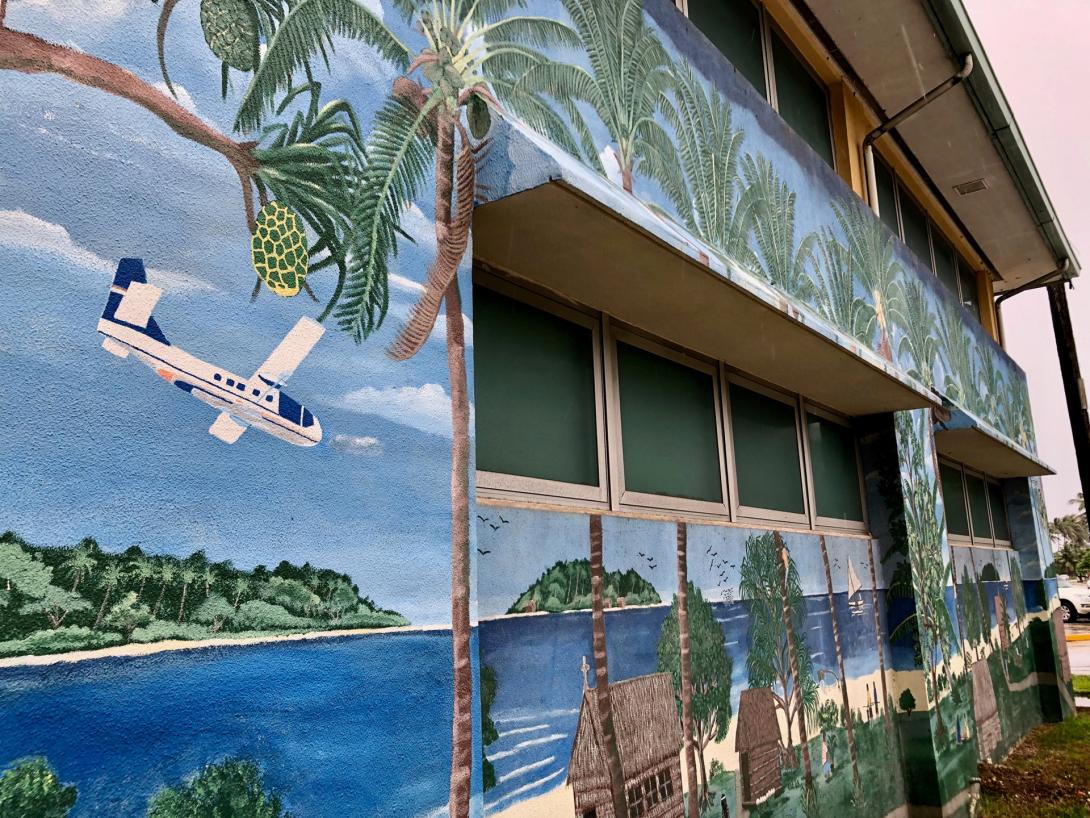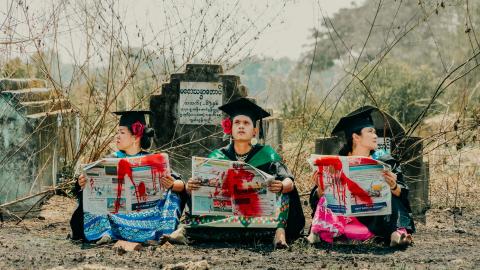Air Canoe
APT10
The Air Canoe project focuses on the northern Oceanian region of islands and atolls known as central Micronesia. The project reclaims indigenous Islander peoples’ connections to and relationships with water, land and skies — as well as to the past, present and future — through contemporary artistic reworkings of culture, history and technology; and responds to the ongoing history of military and colonial domination in a region where the air itself is colonised. Air Canoe seeks to subvert this military-colonialist itinerary by featuring Islander agency, ingenuity, resilience, inter-connectedness and interrelatedness, and acknowledging the rich indigenous Micronesian histories and discourses of interconnectivity between and among human, non-human, island, water and sky worlds.
Featuring a diverse range of practices, Air Canoe highlights how local artists navigate the currents that swirl around them, including waves of liquid, air, sound, migration, memory, militarism, radiation, climate change and, most recently, the novel coronavirus.
Air Canoe co-curators: Greg Dvorak, Ruha Fifita and Ruth McDougall, with Deeleeann Daniel and Emelihter Kihleng (Urohs Fever)

Collaborative mural decorating building for Youth to Youth in Health organisation, Majuro, Marshall Islands / Photograph: Dr Greg Dvorak
Artists
Amran Enos
Republic of the Marshall Islands b.1950
Kathy Jetñil-Kijiner
Republic of the Marshall Islands b.1987
Kathy Jetñil-Kijiner is a poet, teacher and performance artist born in the Marshall Islands. Her poetry primarily focuses on cultural issues and threats faced by her Micronesian people. These include nuclear testing conducted in the Marshall Islands, militarism, the rising sea level as a result of climate change, forced migration, and economic adaptation. In 2014, she was chosen to address the UN Climate Summit in New York City, and in 2017 she performed at the opening weekend of the inaugural Honolulu Biennial. Her first book of poems, Iep Jāltok: Poems from a Marshallese Daughter, was published in 2017. Jetñil-Kijiner works across artistic disciplines with her poetry, often focusing on weaving, which underpins the traditional spiritual and social structure of Marshallese life.
The Digital Paafu Collaborative – University of Minnesota (Twin Cities), United States
(Prof. Vicente M Diaz, American Indian Studies; Prof. Daniel Keefe, Computer Science and Engineering; Graduate Research Assistants in Computer Science and Engineering: Sean Dorr, Zahara Spilka and Kiet Tran)
'The Digital Paafu Collaborative – University of Minnesota (Twin Cities)' is a group of Indigenous and non-Indigenous faculty and graduate students who are part of the Back to Indigenous Futures project at the University of Minnesota (Twin Cities). Working between disciplines and across cultures, the group also partner with Micronesians of Milan, a rural town in Minnesota, as they partner with members of the Lower Sioux Community of Dakota Indians, to revitalise their canoe traditions and traditional knowledge associated with water.
Polowat community, Hawai’i: Celestine Emwalu, Dickson Emwalu, Phillipy Emwalu, Siena Emwalu and Susy Kauka
Federated States of Micronesia/United States
The artists of the paafu and canoe are from Polowat Atoll, but are all now living on O’ahu island in Hawai’i. Polowat is in the Central Carolinian region of the Federated State of Micronesia. Politically, Polowat is a municipality in Chuuk State. Polowat is famous for continuing to build and sail ocean going outrigger canoes (called wa herak) using traditional (pre-contact) skills and knowledge. For this reason, and like their close relatives in Satawal (also in the Central Carolines, but part of Yap State in the Federated States of Micronesia), Polowatese are highly regarded as holders of deep cultural knowledge about the sea. The people from this region are referred to as Re Metaw, People of the Sea. The artists range in ages from 34 to 62 and are all related. On their paternal lineage, they belong to the Utt Lefanifarh (Lefanifarh Canoe House) and, on their maternal lineage, to the Utt Wenimai (Wenimai Canoe House).
Urohs Fever
Eliwy Aggripa, b.unknown; Kukileen Albert, b.c.1973; Yukimi Barnabas, b.1976; Elygene Benjamin, b.1987; Kimberly Dakamas, b.1994; Rodleen Daniel, b.1974; Caroline Donre, b.1963; Jacelynn Donre, b.1984; Elwihter Ehsa, b.1974; Patsihpa Ioanis, b.1998; Vicky Itiota, b.1973; Leonides Miguel, b.1970; Aileen G Moses, b.1976; Burt Moses, b.2001; Regina Pelep, b.1985; Eriuter Route, b.1989; Beverly Ann Seiola, b.1986; Virginia Tom, b.1977, Geraldine Torres, b.1975, Younerine 'Oroko' Thomas, b.1961 and Enolynn Thomas, b.1964. Pohnpeian Sohn Deidei (Pohnpeian Seamstresses)
Federated States of Micronesia
Curated by Emelihter Kihleng and Deeleeann Daniel, Urohs Fever focuses on the art of urohs making, creativity, and the lovers and businesswomen for whom the textiles represent much more than an ‘island skirt’. The urohs displayed in APT10 include new commissions as well as skirts on loan from various collectors, including the Pohnpeian co-curators and photographer. This project celebrates the genealogy of women’s cloth production, and the vibrancy, joy, generosity and passion that goes into the making and circulation of these incredible Pacific Islands textiles.
Waa (canoe)
Deoniare Keju b.1959 with BJ Amon, Akious Anitak, Isaiah Benjamin, Ramos Bolear, Bukko Elso, Anikoj Loeak, Albert Sam and Milton Saimon
Republic of the Marshall Islands
Marshallese boys are encouraged to imagine and create seafaring vessels, starting with small toy sculptures that are raced on the ‘ocean side of the atoll when it is low tide and the water is only about six inches above the reef’. The replicas, known as riwut, are traditionally made of pandanus and coconut leaves, but on urban Ebeye, where displaced Marshall Islanders live in the shadow of the US military base on Kwajalein Atoll, these materials are scarce, so young boys fashion their waa from soda cans. An avid photographer and teacher working for the Education department, Deonaire Keju documents the young creators as they create individual sculptural replicas for racing.
Wotje Weavers
Keju Alvin, b.1951; Ketty Boktok, b.1973; Janice Gold, b.1973; Buoj Hax, b.1954; Leindrik Jacob, b.1982; Naer Kiota, b.1956; Almitha Lanwi, b.1974
Republic of the Marshall Islands
Brightly coloured, elaborate flowers are a relatively recent innovation attributed to women artists in Wotje (Wōjjā) Atoll — one of the four district sub-capitals of the Republic of the Marshall Islands. An important Marshallese cultural site in the Ratak Chain for millennia, Wotje was used as a small civilian trading outpost during German (1884–1914) and Japanese (1914–45) colonial periods. Today, Wotje women resourcefully continue to demilitarise their atoll by excavating and detangling its war-era power cables and repurposing the copper wire to shape the petals of their creations, transforming the violent technologies of militarism and colonialism into expressions of beauty and kindness.
Marshall Island Weavers
Kajnet Alfred, b.1967
Majuro Weavers
Republic of the Marshall Islands
The women gathered in the Majuro shop Elefa Handicrafts, run by local businesswoman Lucia Guavis, hail from across the archipelago of islands and atolls that comprise the Republic of the Marshall Islands. Each has a different story to tell of the reason for their journey to Majuro and the place where they grew up. What they all share is the language of weaving. In this, they are considered experts. Be it the creation of beautiful shell and fibre earings and neck adornments, neat handbags for carrying to Church, white finely woven hats or the quirky marine and plant sculptures Lucia sells to tourists, the weavers approach the task with consummate skill and a sense of enthusiasm and joy born out work achieved in the company of close colleagues and friends.
Miracle Flowers (Kosrae)
Ines J Alokoa & Seniolyn T Moris
Federated States of Micronesia b.1955
Born on Kosrae, Ines and Seniolyn were taught by their female elders, as young girls, to weave customary mats. Later, they both had opportunities through church-funded exchanges to collaborate and learn new textile skills from fellow artists from nearby islands and atolls. This along with exposure to the wide range of woven products created using found materials for tourists by women from other islands, brought to Kosrae or encountered at local festivals has inspired the creative exploration of locally available materials such as the taro leaf dyed with bright synthetic dyes as a new material for new decorative forms.
Rookie Boys
Federated States of Micronesia, est. 2013
Raynold Tilfas (Lead Artist)
Federated States of Micronesia b.1990
Choir members: Jaffody Abe b.1999; Paliksru Abe b.1999; Kenny Edwin b.1995; Rohl Elsi b.1999; Dwight Esau b.1998; Ranson Esau b.2001; Yoshimasa Isisaki b.1999; Joseph Lik b.1991; Kaiyen Lik b.2001; Robert Lik b.1991; Seletin Lik b.1999; Weston Luckymis b.1995; Mason Rim b.2000; LG Robert b.1995; Bohr Sig b.2001; Mason Sig b.1995; Brence Wesley b.1999
Federated States of Micronesia
Rookie Boys are a group of young men from the lush volcanic island of Kosrae, easternmost of the four states in the Federated States of Micronesia. Since missionary times, Protestant Congregationalist churches throughout Kosrae have played a key role in everyday life, and people of all ages take great pride in their finely tuned singing of traditional hymns and gospel songs. Raynold ‘Kutkut’ Tilfas, a young father from the coast of Lelu Village, formed the all-male group in 2019 as a way to build community and keep young men sober and engaged with life.
